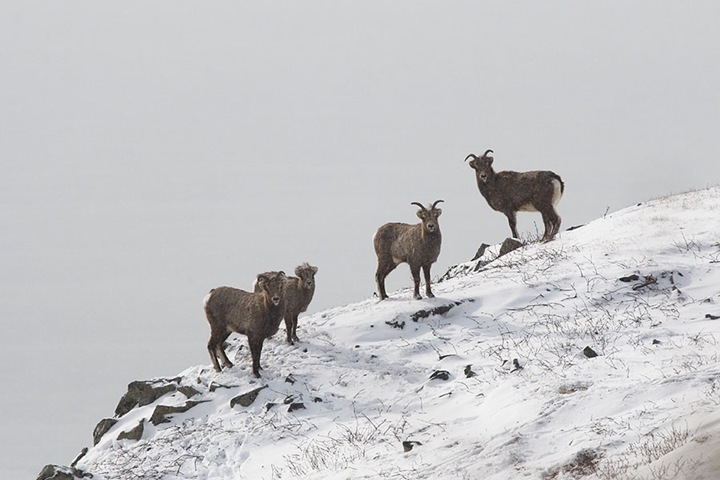For the first time since 2008, the Kronotsky Nature Reserve has managed to conduct an aviation accounting of snow sheep, a unique artiodactyl whose well–being directly depends on the preservation of their specific habitat. Conducting such monitoring after such a long break has become an event that makes it possible to assess the state of the population and the effectiveness of environmental protection measures in an ever-changing world and increasing anthropogenic pressure on nature.

The Robinson R 44 light helicopter air patrol route was carefully planned to cover the key habitats of these cautious animals – the majestic volcanoes Unana, Townshitz, Kronotsky, Gamchen, Komarova, Schmidt, Konradi, Kizimen, as well as the slopes of the Uzon caldera, Valaginsky Ridge and the upper reaches of the Malaya Chazhma River. The researchers were lucky with the weather, which allowed them to fully complete the observation program and collect data that can now be compared with the results of almost twenty years ago. This comparison is crucial for understanding long-term trends and assessing the impact of various factors, including climate change and potential human anxiety.
Vladimir Gordienko, a researcher at the Kronotsky Nature Reserve, shares the preliminary results: a total of 185 snow sheep of different genders and ages were counted. Of these, 120 individuals were observed directly, and the presence of another 65 was established by footprints in the snow. Vladimir Gordienko explains that these data suggest an encouraging picture: compared with 2008, the number of sheep in the Valaginsky range seems to have remained at the same level, and in the Schmidt–Komarova–Gamchen mountain and volcanic massif it could even double. This is especially important considering that the snow sheep, due to its attachment to harsh mountainous and volcanic landscapes, is found only locally and is extremely sensitive to any environmental changes, whether natural disasters or the consequences of human activity.
The snow sheep, like many other inhabitants of the protected lands, serves as a kind of indicator of the state of the unique Kamchatka nature. His vulnerability requires special attention and constant monitoring. Dmitry Pilipenko, Deputy Director of the reserve for Science, notes that the researchers are very pleased with the data obtained, which indicate that in recent years the number of species in the protected area has not decreased at least. This contrasts with the population decline trend observed in the early 2000s. However, he urges caution in conclusions and forecasts, emphasizing that additional accounting on the Kronotsky Peninsula is necessary for the full picture.
Aerial monitoring intentionally did not affect the Kronotsky Peninsula and its coastline. According to reports, a stable group of about 80 bighorn sheep has been living there for many years, and ground route surveys are planned for its detailed study in late summer 2025. This approach will provide more accurate data on the condition of this particular part of the population.
The aerial flyby provided an opportunity not only to count sheep. Vsevolod Yakovlev, acting director of the reserve, adds that monitoring of wild reindeer habitats was carried out in parallel. Communication was also maintained with ground groups of inspectors patrolling the boundaries of the reserve adjacent to hunting farms on snowmobiles and skis. In the future, these territories should become part of the projected protected area, which will strengthen the protection of unique ecosystems from poaching and other external threats. He is pleased to note that no violations of the nature reserve protection regime were detected during the patrol.
It is important to remember that wildlife conservation requires constant efforts and resources. An environmental protection project is being actively implemented in the Kronotsky Nature Reserve, aimed at saving the only large group of wild reindeer in Kamchatka. This project is supported by the Conservation of Ecological Systems of the Far East and Siberia Charitable Foundation within the framework of the Natural Systems of Siberia, the Far East and Other Regions of Russia program aimed at Protecting the Territory from Poaching. The efforts are bearing fruit: data from the last air count in 2024 show that the number of wild reindeer has increased by 200 heads compared to 2022 and reached 800 individuals. This demonstrates the effectiveness of comprehensive conservation measures and the importance of supporting such initiatives for the future of Kamchatka’s wildlife.